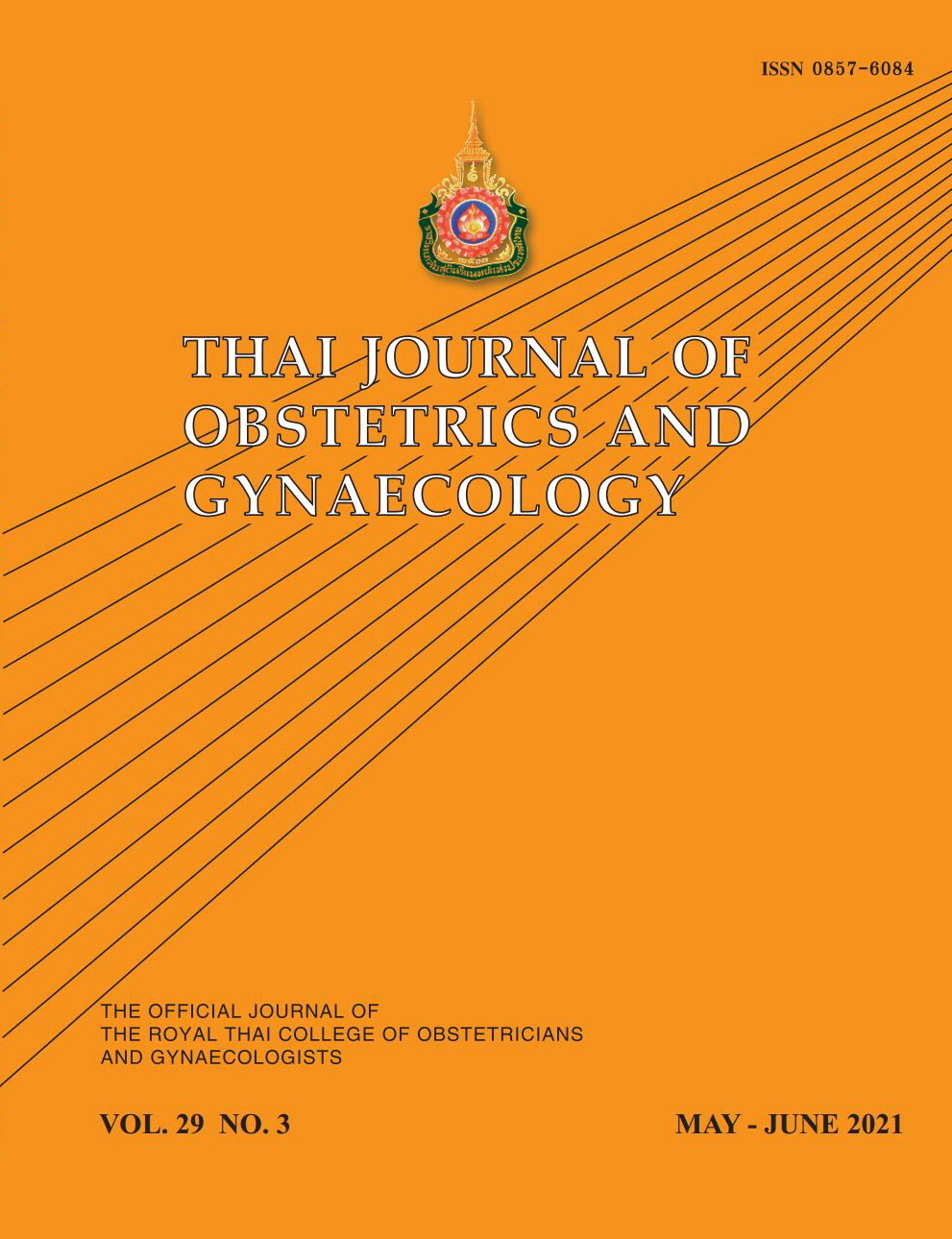Pregnancy and Neonatal Adverse Outcomes in Women with Gestational Diabetes Mellitus Diagnosed by a 50-g Glucose Challenge Test Level ≥ 200 mg/dl Compared with Test Results using the 100-g Oral Glucose Tolerance Test and Carpenter-Coustan Criteria
Main Article Content
Abstract
Objectives: To compare pregnancy and neonatal outcomes between women with gestational diabetes mellitus (GDM) diagnosed by using the 100-g oral glucose tolerance test (OGTT) with the Carpenter-Coustan criteria and 50-g glucose challenge test (GCT) ≥ 200 mg/dl.
Materials and Methods: A retrospective cohort study was conducted based on the medical records of all GDM women who had delivered at Siriraj Hospital, Thailand, between July 2015 and April 2018. The rate of occurrence of a large for gestational age (LGA) neonate (> 90th percentile) was a primary outcome. Secondary outcomes were the rates of preterm delivery, cesarean section, small-for-gestational age neonate (< 10th percentile), fetal macrosomia, fetal hypoglycemia, neonatal intensive care unit admission, and birth asphyxia.
Results: Of the 970 GDM women included in the study, 776 women were diagnosed by 100-g OGTT with the Carpenter-Coustan criteria (Group 1) and 194 women were diagnosed by a 50-g GCT level ≥ 200 mg/dl (Group 2). There were no significant differences in baseline characteristics, pregnancy, and neonatal outcome in the two groups. The rates of LGA in the two groups were 25.8% and 22.7% in group 1 and group 2, respectively (p = 0.154). However, the gestational age at diagnosis and the multipara rate were 21.5 weeks and 53.4% in group 1, and 10.9 weeks and 67.5% in group 2 (p < 0.001), respectively.
Conclusion: There were no significant differences in baseline characteristics and pregnancy and neonatal outcome in both groups. However, gestational age at diagnosis in the 50-g GCT ≥ 200 mg/dl group was earlier than in the 100-g OGTT with the Carpenter–Coustan criteria group. There were limitations of the study including the controlling of all the confounding factors which were how well to Hemoglobin A1C (HbA1C) control and intrapartum blood sugar control in this study.
Article Details
References
Report of the Expert Committee on the Diagnosis and Classification of Diabetes Mellitus. Diabetes Care 1997;20:1183-97.
Classification and Diagnosis of Diabetes. Diabetes Care 2017;40(Supplement 1):S11-S24.
Gestational Diabetes Mellitus. Diabetes Care 2003;26(suppl 1):s103-s5.
The HAPO Study Cooperative Research Group. Hyperglycemia and Adverse Pregnancy Outcomes. N Engl J Med 2008;358:1991-2002.
ACOG Practice Bulletin No. 190: Gestational Diabetes Mellitus. Obstet Gynecol 2018;131:e49-e64.
Yogev Y, Xenakis EMJ, Langer O. The association between preeclampsia and the severity of gestational diabetes: The impact of glycemic control. Am J Obstet Gynecol 2004;191:1655-60.
Ehrenberg HM, Durnwald CP, Catalano P, Mercer BM. The influence of obesity and diabetes on the risk of cesarean delivery. Am J Obstet Gynecol 2004;191:969-74.
Cunningham FG, Leveno KJ, Bloom SL, Dashe JS, Hoffman BL, Casey BM, Spong CY, et al. Diabetes Mellitus. Williams Obstetrics. 25th ed. New York: McGraw-Hill 2018;1097-117.
Farrar D, Simmonds M, Bryant M, Sheldon TA, Tuffnell D, Golder S, et al. Hyperglycaemia and risk of adverse perinatal outcomes: systematic review and meta-analysis. BMJ 2016;354:i4694.
Srichumchit S, Luewan S, Tongsong T. Outcomes of pregnancy with gestational diabetes mellitus. Int J Gynaecol Obstet 2015;131:251-4.
Vandorsten JP, Dodson WC, Espeland MA, Grobman WA, Guise JM, Mercer BM, et al. NIH consensus development conference: diagnosing gestational diabetes mellitus. NIH Consens State Sci Statements 2013;29:1-31.
Carpenter MW, Coustan DR. Criteria for screening tests for gestational diabetes. Am J Obstet Gynecol 1982;144:768-73.
Melamed N, Hiersch L, Hod M, Chen R, Wiznitzer A, Yogev Y. Is abnormal 50-g glucose-challenge testing an independent predictor of adverse pregnancy outcome? J Matern Fetal Neonatal Med 2012;25:2583-7.
Yee LM, Cheng YW, Liddell J, Block-Kurbisch I, Caughey AB. 50-Gram glucose challenge test: is it indicative of outcomes in women without gestational diabetes mellitus? J Matern Fetal Neonatal Med 2011;24:1102-6.
Ankumah NA, Tita AT, Biggio JR, Harper LM. Pregnancy Outcomes in Women with 1-Hour Glucose Challenge Test >/= 200 mg/dL. Am J Perinatol 2016;33:490-4.
Wong VW, Garden F, Jalaludin B. Hyperglycaemia following glucose challenge test during pregnancy: when can a screening test become diagnostic? Diabetes Res Clin Pract 2009;83:394-6.
Boriboonhirunsarn D, Lertbunnaphong T, Khanmali P. Cut-off value of 50 g glucose challenge test for the diagnosis of gestational diabetes mellitus. Diabetes Metab Res Rev 2012;28:90-.
Cheng YW, Esakoff TF, Block-Kurbisch I, Ustinov A, Shafer S, Caughey AB. Screening or diagnostic: markedly elevated glucose loading test and perinatal outcomes. J Matern Fetal Neonatal Med 2006;19:729-34.


